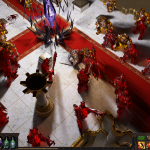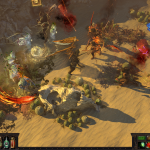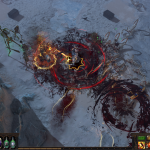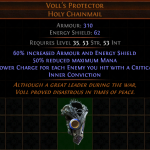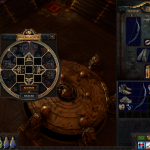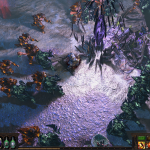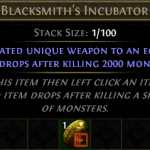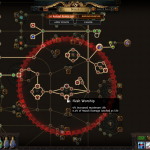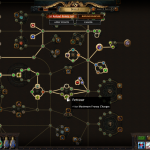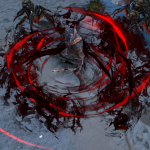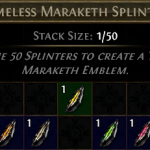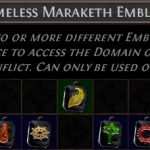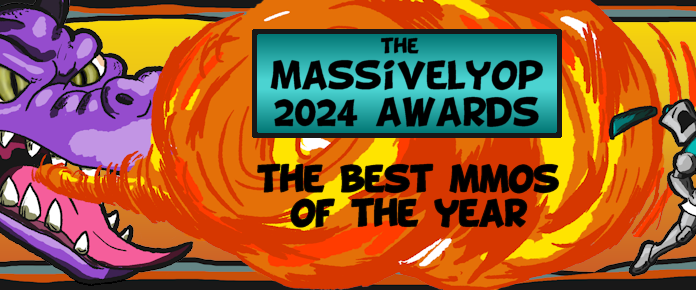
Oh, some times I think back to when Path of Exile was younger
Life was so much simpler then…
Let me tell ya now
Those were the good old days
Little did you know that Weird Al Yankovic would so aptly describe Path of Exile’s next league way back in 1988. But he did. (Just don’t read too much into the rest of the song!) A new quarter is starting, so it’s time once again to learn about the next big update for Grinding Gear Games’ popular MMOARPG, which will launch for the PC on June 7th, 2019, and hit both consoles on June 10th. I enjoyed sitting down with Producer Chris Wilson to learn the ins and outs of expansion 3.7.0, titled Legion. And there was plenty to learn.
Much like the song above, Legion will be a blast from the past — in more ways that one. First, Wilson noted that while leagues of late have build building up in complexity, culminating in Synthesis, Legion hails back to the simpler leagues of long ago like Abyss and Breach (players’ all-time favorite). Secondly, Legion is all about the past of Wraeclast: It showcases the five great armies from the land’s history along with their generals. You are ready to take on whole armies, right?
Of course, there’s always more to the expansion than just a league, and Legion’s most notable change will be the massive melee revamp. Add in new archetypes, new items, an early-game monster rebalance, and Atlas map improvements and you’ve got a meaty expansion.
A blast from the past
Why make Legion simpler? Might folks consider that insulting? Wilson detailed why the team needed to back off from creating more and more complex leagues. One, it simply isn’t sustainable. He explained how Synthesis hit the limit of what GGG can produce in the allotted time frame; to try to do more would require more overtime and possibly burning the devs out, which he is not willing to do. Wilson further explained,
“We were hitting a thing where because we were getting more complex in terms of the amount of meta systems added to these leagues that players were expecting more complexity with each one. And I feel we crossed a point of sustainability with Synthesis where we hit the amount of complexity that people were expecting the creep to reach, but in doing so we made it a little [less] understandable for certain players.”
Wilson described how the complexity seemed to hit the tolerance limit of many players. Two of the most popular leagues have been Breach and Abyss, where players just get to just rampage through and speed kill for rewards. Legion goes back to that, except it goes a step further: Legion give players more control over the experience by allowing them to customize it. Wilson actually worries that the league may not be complex enough for those who love that aspect most, but noted that the game itself already is already plenty complicated. “To some extent it’s moving the complexity into the reward system rather than in how you actually engage with a specific areas you’re playing in.”
 Going with Legion helps break the expectations for complexity creep. Wilson noted that while some players will look at this as a regression and question it, he’d rather let players now that this will occasionally happen instead of an unsustainable path that burns the staff out and prevents work on other projects.
Going with Legion helps break the expectations for complexity creep. Wilson noted that while some players will look at this as a regression and question it, he’d rather let players now that this will occasionally happen instead of an unsustainable path that burns the staff out and prevents work on other projects.
And for those who do enjoy the more complex leagues, don’t worry: This move back to simpler ones is not a constant. Wilson said that going forward there is likely to be a mix of league types as opposed to the unsustainable trajectory they were on before; GGG will probably target two complex leagues a year instead of all four. It all depends on what the game needs at the time, he explained. The upcoming December expansion, 3.9.0, is already likely to be a complex one due to the ideas the team has for it. He said,
“It depends where the ideas go. Legion was an idea we thought we could do without too much complexity, so we jumped at the opportunity to try a simple one out and gain some time — and burn the players out less. But if we have a complex idea, we will probably run with it.”
Legion won’t be totally devoid of complexity either, Wilson noted; it will be there in how players approach the endgame. “Strategically, of course, it’s going to be quite difficult for players to work out how to optimize their rewards here,” he said.
 Revisit the past on the battlefield
Revisit the past on the battlefield
Legion focuses on the past in theme as well. The nitty gritty of Legion is that five iconic armies from the past of Wraeclast are locked into eternal struggles that players can witness — and engage. While adventuring, players will run into monoliths that will summon forth two armies frozen in battle. There is a short amount of time where players can select which combatants they wish to unfreeze in order to fight and loot themselves. Called “untethering” from the Domain of Timeless Conflict, this happens by dealing damage to tag the statuesque monsters. At the end of the time limit (probably 10 seconds), all still-frozen combatants disappear and the player is left to battle the rest.
Besides loot, fighting these armies yields splinters, which will be used in more advanced gameplay. Combining 50 splinters together will make an emblem, and there is one emblem for each army. After choosing which two emblems to make (or for more of a challenge, three, four, or all five), the players can add them into the map device to open a portal to the Domain of Timeless Conflict, where they enter and repeat the untethering process on the armies they chose to face through their emblem selection. This time, however, the frozen combatants will have symbols over their heads to indicate who has the most valuable rewards. Wilson emphasized that this is where the big risk vs. reward decisions will come into play. In this way, players will customize their own event.
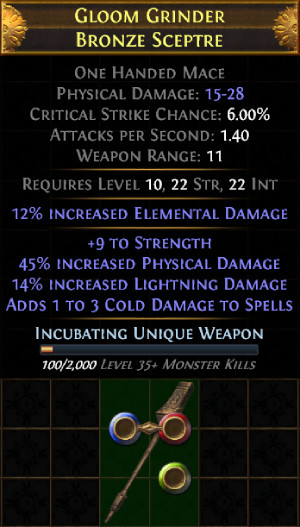 With the old comes the new (items)
With the old comes the new (items)
I mentioned you could put five emblems in the map device: That’s because in Legion, players will be able to unlock a fifth slot in it! It won’t be easy, but it could be very worth it; doing so will open that slot for not just legion portals but all other atlas map content as well. Players can reap significant rewards from boosted maps. Wilson said GGG is unsure whether the five-slot map device will make it into the core game after legion ends, but it is a possibility.
Legion is also introducing incubation items. Monsters will drop incubators, which exiles will then attach to any piece of gear. After players kill enough enemies while wearing this incubator, it will modify that piece of equipment to guarantee a certain type of item drop. Incubators come in common, uncommon, and super rare.
There are unique rewards specific to the legions. And boy, these add some interesting things into the game. Wilson unveiled two of these. The first was Aukuna’s Will Clasped Mitts. These gloves have two impressive properties for summoners: One, raised zombies don’t need a corpse, and two, raised zombies count as corpses. Imagine being able to call forth zombies even in barren areas, and then combining detonate dead with your live zombies? It’s like an infinite supply of walking bombs! The second unique is Voll’s Protector Holy Chainmail. Wilson explained that this item was already in game, but pretty meh, so devs souped it up. Now, it has Inner Conviction.
And just so you know, Voll’s Protector won’t be the only revamped item. Wilson told me that in addition to new rewards in general, players will see revamped versions of more 15 uniques as well as 12 brand-new ones.
Make way for new melee
While there is much more going into the expansion, the centerpiece might just be the game-wide revamp of everything melee. It turned out to be a much larger project than the team expected. “This revamp is far more extensive than the spell-casting one that we did in Synthesis,” Wilson stated. “We’ve kind of taken the game back to its base fundamentals and said ‘How do we want combat to actually work?’ and changed a lot of stuff.” He emphasized that more than half of the effort put into this expansion went directly into the melee revamp “in order to try to get melee combat to be as good as [GGG] can do.” Since the studio wants the game to be around for 20 years, it intends to keep fixing each aspect in an iterative cycle, and now it’s melee’s turn.
What is different? Here’s a quick glimpse. Attack animations can be canceled at the beginning or after they deal their damage to create a more-responsive feeling combat. Low-level movement skills have been added so all classes have them, and movement activates instantly to allow players to dodge better. Melee targeting was improved, range indicators were fixed, accuracy’s cap of 95% was removed, and many existing melee skills were reworked to function better (such as Cyclone becoming a channeling skill). Oh, and all melee attacks can now hit multiple adjacent enemies. Wilson stated that the entirety of the animation system for melee was overhauled, and that supports animation chaining and dynamic speed changes.
And that’s just a glimpse!
 But wait, there’s more
But wait, there’s more
Besides just melee skills, other core changes are happening with Legion, including a rebalance of the monsters early on in the game. With all of the melee combat improvements, players will have the ability to dodge out of the way of attacks. To take advantage of that new ability, players will find that more mobs will now have attacks that are signaled, adding a wind up to attacks that packs a bigger punch, encouraging (especially new) players to learn and use their movement skills. “We improved the AI of the monsters, we added new skills to the fights, we improved on the boss fights,” Wilson said, “and basically started polishing the beginning of the game to meet a 2019 standard. […] There’s a lot more engaging gameplay going on: It’s less standing next to the thing and hoping it dies before you do.”
Legion also introduces two new Archetypes. There’s the Blood and Sand Gladiator, where blood and sand are stances that the Duelist can switch between: Blood does lots of damage to close enemies, and sand is more of a defensive AoE. This archetype uses the new skills Blood and Sand, Flesh and Stone, and Bladestorm.
The second archetype is Rage Berserker. In Legion, rage no longer drains life from the Berserker over time unless the player chooses to in order to increase power. New skills will generate rage, and the Berserk skill consumes rage to give very powerful multiplicative attack bonuses.
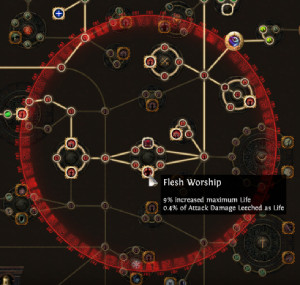 The next game-wide addition we have is a set of new jewels . Each of those five legions has a special unique jewel that players can socket in their passive skill tree. What is so amazing about these jewels is that they actually have a large radius area of effect that adds properties to all the passives that fall within the range. This creates completely new character customization options to endgame. Wilson noted that these gems would be easy to move into the core game after the league so players can make all sorts of crazy characters.
The next game-wide addition we have is a set of new jewels . Each of those five legions has a special unique jewel that players can socket in their passive skill tree. What is so amazing about these jewels is that they actually have a large radius area of effect that adds properties to all the passives that fall within the range. This creates completely new character customization options to endgame. Wilson noted that these gems would be easy to move into the core game after the league so players can make all sorts of crazy characters.
Endgame hasn’t been left out. Wilson noted that the team always tries to tweak and add here as well. This time around, boss fights have been improved in about eight of the maps, and other maps have gotten improvements with things like pathing. And maybe, just maybe players can look forward to the five-slot map device making it into the core game.
ExileCon and world launches
For those excitedly awaiting ExileCon, Grinding Gear Games has locked in the attendance of the whole trifecta of original Diablo 1 and II creators. David Brevik, Max Schaefer, and Eric Schaefer will be attending to talk with fans, share information on their projects, and sign autographs and such.
Regarding the South Korea launch, GGG is partnered with Kakao Games. One difference with this launch is that folks playing the Korean version can play on same realm as others; it is not a separate game as in China and Taiwan.
“Despite the fact Synthesis isn’t getting rolled into the core game, people will definitely see a Synthesis thing at some point in the future,” Wilson said. That can happen with the way the devs guest other league content into the game, such as finding Harbinger things in a Delve encounter.
 What if your world changed every three months? What would you do differently? Path of Exile does, and MOP’s MJ Guthrie explores and experiences each new incarnation in Wandering Wraeclast. Join us biweekly for a look into each new challenge league and world expansion — and see whether MJ can finally reach the end of one world before it ends!
What if your world changed every three months? What would you do differently? Path of Exile does, and MOP’s MJ Guthrie explores and experiences each new incarnation in Wandering Wraeclast. Join us biweekly for a look into each new challenge league and world expansion — and see whether MJ can finally reach the end of one world before it ends!
